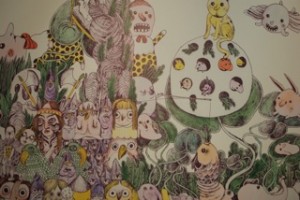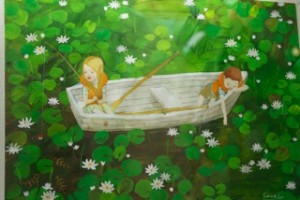 A couple of weeks ago I went to the Children’s Media Conference in Sheffield. This year’s is the conference’s 10th and in a decade it’s grown from something you could have fitted in the back room of a pub, to a 900 delegate-international-multiple-session-three-day-jamoboree. It was quite simply wonderful: beautifully organised, without being regimented, full of fascinating sessions across a huge range of topics AND there was dancing (though sadly, as I had a session to chair at 9am the next morning I had to run out with Cinderella at midnight).
A couple of weeks ago I went to the Children’s Media Conference in Sheffield. This year’s is the conference’s 10th and in a decade it’s grown from something you could have fitted in the back room of a pub, to a 900 delegate-international-multiple-session-three-day-jamoboree. It was quite simply wonderful: beautifully organised, without being regimented, full of fascinating sessions across a huge range of topics AND there was dancing (though sadly, as I had a session to chair at 9am the next morning I had to run out with Cinderella at midnight).
As the sort of person who’s normal setting is hiding-under-a-stone-working I’ve never been much of a conference go-er. But I have had three different careers, so like driftwood in the sea, I have acquired conferences like random barnacles. My first career, as a zoologist, was my most conference rich. Wide eyed with excitement I went to conferences on birds and bats and whales, with my pencil sharpened and my eyes bright. I was, back then, completely oblivious to any of the networking or socialising options available at a conference; I was there to download information into my brain and to do a small amount of hero worship of successful academics, studying glamorous species in exotic locations. At the end of any session I was the bonkers one pinning the poor lecturer against the wall with intense questioning. The titles and content of some of the lectures I attended are still with me, and the almost physical thrill of being told new things about the natural world (anyone else who went to the Edward Grey Institute Conference in 1979 remember John Harper’s fabulous talk called ‘Clutch Size In Plants’ ?)
My third career as a writer has been conference poor. Although I had a lectureship in Creative Writing, I was always keen to get back under my stone, so the only things approaching ‘conferences’ in my writing life have been appearances at literary festivals. These consist of me sitting nervously on the sofas in the green room/authors yurt/ artists cafe/ whatever, and feeling that at any moment someone is going to throw me out; then doing the sort of performance zoology I do in school halls, only in a tent to the accompaniment of flapping canvas. I don’t really learn anything and seldom meet anyone (although me and Rose Impy had a lot of fun at Edinburgh year before last, egged on by Steves, Skidmore and Barlow – who could get Mary Whitehouse to misbehave). The most exciting outcome of these events is that afterwards I find out I was sitting on the sofa next to someone dead famous who I didn’t recognise at the time. After Edinburgh one year I found I’d been sitting between Alan Stiletto (who’d I was astonished to find was still above ground) and Diana Athill.
But my second career in TV as a presenter and writer was utterly devoid of conferences, festivals or any kind of interaction that puts your work in a wider context. Back then I was swimming so hard to keep my nose above water that I never thought of anything beyond the next deadline, the next day filming or in a studio. So the CMC this year was a wonderful revelation. I went to sessions run by commissioning editors from commercial Tv and games, publishing and children’s BBC; I went to research sessions about children’s use of the internet; I heard the stories of successful series that are global phenomena (that I’d never heard of); I learnt some new phrases such as ‘platform agnostic’ (meaning- I think – a creation that works across lots of devices and outlets- TV/Online/game consul). I was sometimes depressed by the self congratulatory attitude of some commercial media executives, expressing an attitude to children’s consumption of media that, transposed to children’s eating habits, would amount to saying ‘well, if children want to eat nothing but crisps and sugar then that’s what we have to give them’. But I was inspired by a wonderful session about children’s theatre (came out of that one with SOOOO many ideas and plans). And I saw people I hadn’t seen for twenty years including Anna Home who looks younger and more dynamic now then when she was head of BBC children’s in the 90s. (take heart Joe Godwin…all the years you gain in post you instantly shed when you leave).
There were many highlights ( Shone Reppe talking about her story of the man who married a woman the size of a raisin; Swampy Marsh talking about how Phineas and Ferb came to life; making giraffe hands with Catherine Bennett and Taylor Houchen) but there were two really outstanding take home messages for me. One was about the value of passion and the other about narrative. The session I chaired on the last morning, ( produced by Sai Pathmanathan – fabulous science communicator, and my dear old colleague from CBBC days, Ali Stewart) was called ‘Entertainment its Natural’ and was about how biological science is represented in TV, games and online material. The four speakers were Sharna Jackson from Tate Kids and the force behind Wonderminds linking brain neuroscience and art; Jonny Keeling head of BBC NHU children’s and responsible for the wonderful Deadly 60, Myles McLeod writer and animator and co author of CBBC’s Pedro and Frankensheep and Fran Scott science presenter and demonstrator across stage and TV. All were first class communicators, who explained the bones and flesh of their own practice fascinatingly. Each had a unique perspective on how biology is communicated to young people using their various chosen media. But what shone out was their passion and their caring – for both their subject and their audience. To hear people articulate the reasons why we need to teach children about the natural world, and the ways in which we can do it, in a fashion that empowers our audience and fires their curiosity, was wonderful. It was hugely encouraging to know that it’s not just me alone with my computer and some blank pages, trying to do this thing; that it IS worthwhile and that it CAN have an impact. The effect on the CMC audience of the session was electric too: so many people came up to us and said how marvellous it was to hear ‘such passion.’ In zoological terms passion is like the roar that rutting stags use to assess each other’s strength, it’s unfakeable.
The other big take home message was the endorsement of the power of narrative. I wish I’d counted the number of times I heard the word ‘story in the three days at the CMC. From Frank Cotterell Boyce’s incredible, heart lifting keynote – ‘we are the stories that we tell’ – and through every other session, the power of that most ancient and potent of human machines, the story, was extolled. There was a recognition that all the special effects, all the pushy buttons and touch screens and glamorous faces in the world, just don’t cut it without a good story to tell. There is nothing too complicated, too upsetting, too big or too small, to be carried in a story – and story doesn’t just mean plot – story means characters that you feel for, emotions that are real. In addition to several thousand years of human history and culture, there is scientific evidence to back up the contention that story works as the most effective delivery system for information, with a demonstrable effect on our ability to assimilate and remember. To tell a story is to truly acknowledge that we learn best holistically, not with our brains alone, but with our senses, our hearts, our bodies, our souls. For scientists who want their research to be understood, this means taking aboard the idea that a law, a theorum, a set of compelling statistics, may find their route into a human mind through the account of a life, through a description of sunlight in the park, or a lost love – through a story. (Myles McLeod expressed this beautifully in his part of our CMC session).
I work in the territory of story. It’s where my heart lives and it what I use to tell my readers about the natural world all around them, to try to reconnect them to it. Before the CMC I had hit a wall. I was really discouraged and disheartened. But seeing my work in a wider context, some of which is not in tune with what I believe and some of which totally is, has reinvigorated me… …And gave me an idea for a session for CMC 14: the finale of CMC this year was popstar creation Taylor Houchen‘s song, posing the question ‘what will the future be like?’ When I was promoting my book about climate  change ‘Gaia Warriors’ I visited schools and heard children anxiously asking this question. They’d picked up bits of information about climate chaos, peak oil, population, food and water crises in the media, but they’d also picked up that adults really don’t want to talk about this stuff to kids. It’s like ‘death’ and ‘the future’ are taboo, and kids get the message that is not OK to ask. So my proposal for a session at next year’s Children’s Media Conference is one on how we represent ‘the future’ with all its behemoth problems to young watchers, listeners and readers. Do we as ‘platform agnostic’ communicators have a duty to try and represent what we think may happen, to prepare them for what may be to come, perhaps even offer a vision of what to aim for? Frank Cotterell Boyce was absolutely right when he said ‘ we are the stories that we tell’ but this is not only true in the context of the past and the way we think and feel about history; it’s true of the future too. To paraphrase FCB “we will become the stories we tell”.
change ‘Gaia Warriors’ I visited schools and heard children anxiously asking this question. They’d picked up bits of information about climate chaos, peak oil, population, food and water crises in the media, but they’d also picked up that adults really don’t want to talk about this stuff to kids. It’s like ‘death’ and ‘the future’ are taboo, and kids get the message that is not OK to ask. So my proposal for a session at next year’s Children’s Media Conference is one on how we represent ‘the future’ with all its behemoth problems to young watchers, listeners and readers. Do we as ‘platform agnostic’ communicators have a duty to try and represent what we think may happen, to prepare them for what may be to come, perhaps even offer a vision of what to aim for? Frank Cotterell Boyce was absolutely right when he said ‘ we are the stories that we tell’ but this is not only true in the context of the past and the way we think and feel about history; it’s true of the future too. To paraphrase FCB “we will become the stories we tell”.

